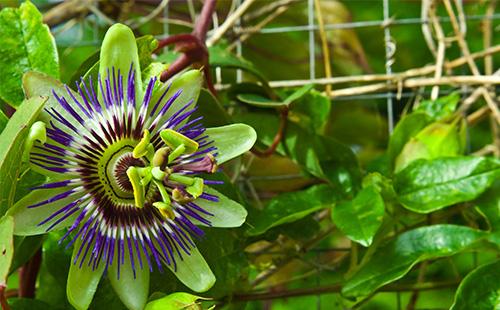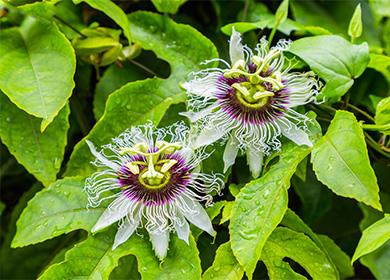The content of the article
As soon as they do not call passionflower in different countries and on different continents. Australians refer to it as nothing more than a "marquise." Brazilians call it a "sweet bowl." And domestic flower growers were nicknamed the "cavalier star" for their similarity to the star of the royal award - the Order of St. Andrew the First-Called. This plant was created not only for beauty, its fruits are actively used in cosmetology, medicine and cooking. In height, the passion flower can stretch for 10 m. For "climbing" on the walls on the stem there are strong, tightly twisted mustaches, with which it clings to the trunks of tropical trees.
Passiflora got its name thanks to the first Christian missionaries who came to the American continent. They were convinced that this flowering liana symbolizes Christ's suffering. Therefore, they named it by the name, which in Greek means literally the following - "the flower of suffering."
What does it look like
Passionflower has over 400 species. Edible passionflower - the most common of them. Passiflora is an ampelous plant (climbing), so a hanging pot will become the most comfortable home for it. The stems of a wildly curling passion flower fall out of the cache-pot, as if yeast dough had risen in a pan. Their juicy green color fits perfectly into the interior of the house. And flowers with a completely cosmic appearance and strong aroma become the real pride of an amateur gardener. You can judge the beauty of a plant by the characteristics of the table.
Table - Appearance and features of passionflower
| Plant part | Features |
|---|---|
| Liana | - evergreen; - the sheet plate consists of three blades 20 cm long; - the leaf edge is cut with small teeth |
| Flower | - single; - inflorescence diameter - 3 cm; - 5 sepals; - 5 petals; - 5 very fragile stamens |
| Fetus | - Egg-shaped; - as a rule, yellow (but the color can be any, up to dark purple); - full ripening of the fetus occurs 2-3 months after pollination |
Healing properties of fruits
From ancient times, the plant is considered medicinal. The fruits of passionflower (passion fruit), which give some types of plants, are a storehouse of nutrients. They contain:
- vitamin A;
- vitamin C;
- all vitamins of group B.
The peel of the fruit is rich in ascorbic acid and is an unchanged ingredient in vitamin complexes and dietary supplements. Indoor creeper leaves can be used as a painkiller. They are thoroughly kneaded, and then applied to a sore spot or wound. In the old days, medicines prepared on the basis of passiflora treated menstrual pains, insomnia and even dysentery.
Passiflora care at home
Growing passionflower at home is a simple and thankful task. Liana grows very fast and almost never freaks out. It captivates with a long and fragrant flowering, in addition, the ability to grow tropical fruit on the windowsill is very attractive. The path to the heart of flowering and fruitful passionflower is high humidity and comfortable warm air temperature all year round. If you are sure that you can provide such conditions to the liana, feel free to replenish your floristic collection with this ampel plant.
Lighting
Caring for passiflora after purchase begins with choosing the optimal location for the flower. If you have a terrace or balcony on the sunny side, settle the liana there. She loves the direct rays of the sun and thanks for their generous flowering. In winter, daylight will not be enough. The daylight of a passion flower should last about 12 hours, regardless of the time of year. Therefore, in the cold season, the grower will have to use artificial light sources. Sometimes the same thing has to be done in the summer, if the liana pot is in the shade or in an insufficiently lit place.
Temperature and humidity
Cold, intense heat and low humidity are the main enemies of passionflower. The optimum temperature for a lianoid bush is considered to be from 20 to 26 ° C. Critical temperatures are above 32 ° C.
Passiflora needs constant spraying and humidity above 70%. Due to lack of moisture, the plant begins to hurt. This instantly affects the quality of its foliage. The most dangerous period for room vines is the heating season. From October to April, the indoor flower should be watered more often than usual, as the topsoil dries quickly due to low humidity. The use of a household humidifier is also desirable. Otherwise, it is impossible to achieve a sufficient level of humidity.
Watering
Passiflora loves balance. Watering should be done as the top layer of the earth dries up. In no case should the plant be poured. This can lead to stagnation of moisture, which will lead to the death of the flower. In winter, completely abandoning watering is also not worth it. Growers with experience recommend at least once every two weeks to moisten the soil in a pot. For irrigation, you can use only settled or pre-filtered water.
Top dressing
The period of active growth and flowering, called vegetative, lasts at passionflower from the beginning of spring until the end of the last autumn month. At this time, the plant needs to be fed monthly. To do this, you can purchase any complex fertilizer for vines. In winter, when the houseplant is resting, there is no need for additional nutrition.

Transfer
Among the recommendations on how to care for passiflora in a pot, one can highlight the following point: only plants that have reached the age of three need a transplant. Before changing the pot, passionflower is not recommended. The frequency of transplantation of passiflora is every three to five years.
Breeding
Propagating the "cavalier star" can be done in two ways: by cuttings and seeds. Each of the methods has its pros and cons.
Cuttings
Features In order to propagate the passiflora by cuttings, you need to take planting material from the mother plant. Cut passiflora is recommended from mid-March to mid-April. Pruning is performed in such a way that there are several internodes on each handle. The place of cutting is disinfected with a weak solution of potassium permanganate. This protects the planting material from decay.
Next steps
- Sprinkle freshly cut cuttings with ash or lower them into water (in both cases, the planting material must be provided with greenhouse conditions).
- After two months, we root each stalk in a separate container.
- For planting cuttings we use neutral or slightly acidic soil.
Seeds
Features If you decide to grow passionflower from seeds, it is best to purchase a package of seed from a trusted manufacturer. Self-collected seeds will give only 30% of seedlings. And if you plant passiflora seeds collected more than a year ago, you should not count on sprouts at all. Germination of such material does not exceed 2%.
Next steps
- We carry out the scarification of each seed (pierce the hard shell).
- Soak the seeds in water at room temperature for two days.
- Seeds that have surfaced, we fish out and discard. They will never turn into sprouts.
- The remaining seeds are laid out on the ground and gently squeeze with your fingers into the soil.
- Cover with glass, provide 12-hour light day and air temperature 25ºC.
- After the appearance of several pairs of leaves, we transplant the sprouts into different pots and continue the traditional care.

Diseases and pests of the "cavalier star"
Indifference of the grower, on whose windowsill a tropical plant grows, can lead to diseases of passionflower. The table shows the most common symptoms and the causes of their occurrence.
Table - Symptoms and causes of passion flower diseases
| Symptoms | The reasons |
|---|---|
| Brownish spots on the edges of the leaves | - Water scarcity; - low humidity |
| Softening and twisting the sheet plate | - Cold in the room; - low humidity |
| Leaves turn yellow and fall | - Low room temperature |
| Slow growth | - Irregular top dressing; - lack of nutrients |
| Thinning shoots and chopping leaves | - Lack of nutrients; - lack of lighting |
| Root base rotting | - Improperly organized drainage; - excess moisture. |
| Spider mite | - Low humidity; - lack of watering |
| Shield | - Inadequate lighting; - low humidity |
| Aphid | - Drafts; - infection from a bouquet brought from the street |
| Mealybugs | - Comprehensive violation of care for the vine (cold, waterlogged or lack of watering) |
To control pests, it is worth stocking up with local insecticides and acaricides. Before use, they are bred, following the instructions on the packaging, and the plant is thoroughly sprayed. If necessary, the spraying process is repeated after two weeks.
Indian tribes to this day are confident that the leaves of passionflower have a miraculous effect on the human body. They treat heart ailments and a strong cough in children and adults.The plant itself is most often sick due to a lack of attention from the grower. Therefore, the key to good plant health is competent and caring care for passionflower at home. To create an eternal summer in the apartment, the flower grower really has to try. But the tropical garden on the windowsill is worth it.

